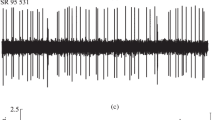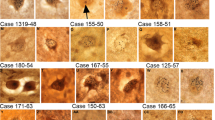Summary
In recent experiments Montarolo et al. (1982) have shown that reversible inferior olive (IO) inactivation of up to 90 s induces a marked increase of the Purkinje cell (PC) simple spike (SS) frequency which lasts as long as the disappearance of the complex spikes (CS). The present work was aimed at studying how long this SS frequency increase lasts. We recorded the electrical activity of 724 PCs from rats (Nembutal anaesthesia 20–40 mg/kg) in which the IO was destroyed by means of cryocoagulation, electrocoagulation and 3-acetylpyridine injection. The SS activity was followed up to 1 month from the lesion. The average SS frequency of the first 5 days is 52.7 (±22.6 S.D.). The difference from the control (22.6±13.7 S.D.) is highly significant (P< 0.001; Mann-Whitney U-test). Later the SS discharge shows a gradual decrease, to reach a value (24.2±12.1 S.D.) similar to the control at the 4th week. Our results demonstrate that the increase of the SS activity, due to the IO lesion, undergoes an adaptation. The time course of such an adaptation is well correlated with the metabolic changes in the intracerebellar nuclei, following an IO permanent lesion, described by Bardin et al. (1983).
Similar content being viewed by others
References
Baetens D, Garcia-Segura LM, Perrelet A (1982) Effects of climbing fibre destruction on large dendritic spines of Purkinje cells. Exp Brain Res 48: 256–262
Bardin JM, Batini C, Billard JM, Buisseret-Delmas C, Conrath-Verrier M, Corvaja N (1983) Cerebellar output regulation by the climbing and mossy fibers with and without the inferior olive. J Comp Neurol 213: 464–472
Batini C, Benedetti F, Buisseret-Delmas C, Montarolo PG, Strata P (1982) Effect of local cooling of the inferior olive on the metabolic activity of the intracerebellar nuclei. Neurosci Lett (Suppl) 10: S61
Batini C, Benedetti F, Buisseret-Delmas C, Montarolo PG, Strata P (1984) Metabolic activity of intracerebellar nuclei in the rat: effects of inferior olive inactivation. Exp Brain Res (in press)
Batini C, Bernard JF, Montarolo PG, Strata P (1983) The olivocerebellar pathway exerts a tonic control on the postural activity. Neurosci Lett (Suppl) 14: S20
Batini C, Buisseret-Delmas C, Conrath-Verrier M, Corvaja N (1981) The effect of harmaline and 3-acetylpyridine on the olivocerebellar-nuclear system in rats studied with 14C2-deoxyglucose. In: Szentágothai J, Hámori J, Palkovits M (eds) Regulatory functions of CNS subsystem. Adv Physiol Sci, Budapest, Akademiai Kiadò, vol 2, pp 145–149
Benedetti F, Montarolo PG, Rabacchi S, Savio T (1983a) Long term functional changes in the Purkinje cell to climbing fibre deprivation. Neurosci Lett (Suppl) 14: S24
Benedetti F, Montarolo PG, Strata P, Tempia F (1983b) Inferior olive inactivation decreases the excitability of the intracerebellar and lateral vestibular nuclei in the rat. J Physiol (Lond) 340: 195–208
Bradley P, Berry M (1976) Quantitative effects of climbing fibre deafferentation on the adult Purkinje cell dendritic tree. Brain Res 112: 133–140
Colin F, Manil J, Desclin JC (1980) The olivocerebellar system. I. Delayed and slow inhibitory effects: An overlooked salient feature of cerebellar climbing fibers. Brain Res 187: 3–27
Desclin JC, Colin F (1980) The olivocerebellar system. II. Ultrastructural correlates of inferior olive destruction in the rat. Brain Res 187: 29–46
Desclin JC, Escubi J (1974) Effects of 3-acetylpyridine on the central nervous system of the rat as demonstrated by silver methods. Brain Res 77: 349–364
Haddad GM, Demer JM, Robinson DA (1980) The effect of lesion of the dorsal cap of the inferior olive on the vestibuloocular reflex and optokinetic system of the cat. Brain Res 185: 265–275
Herken H (1968) Functional disorders of the brain induced by synthesis of nucleotides containing 3-acetylpyridine. Z Clin Chem 6: 357–367
Llinás R, Walton K, Hillman DE, Sotelo C (1975) Inferior olive: Its role in motor learning. Science 190: 1230–1231
Montarolo PG, Palestini M, Strata P (1982) The inhibitory effect of the olivocerebellar input on the cerebellar Purkinje cells in the rat. J Physiol (Lond) 332: 187–202
Montarolo PG, Raschi F, Strata P (1980) On the origin of the climbing fibres of the cerebellar cortex. Pflügers Arch 383: 137–142
Sotelo C, Hillman DE, Zamora AJ, Llinás R (1975) Climbing fiber deafferentation; its action on Purkinje cell dendritic spines. Brain Res 98: 574–581
Strata P, Montarolo PG (1982) Functional aspects of the inferior olive. Arch Ital Biol 120: 321–329
Author information
Authors and Affiliations
Additional information
Supported by National Research Council and Ministry of Education
Rights and permissions
About this article
Cite this article
Benedetti, F., Montarolo, P.G. & Rabacchi, S. Inferior olive lesion induces long-lasting functional modification in the Purkinje cells. Exp Brain Res 55, 368–371 (1984). https://doi.org/10.1007/BF00237287
Received:
Issue Date:
DOI: https://doi.org/10.1007/BF00237287




